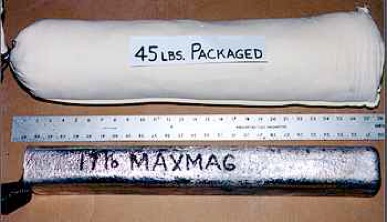All About Magnesium Anodes
- Home
- All About Magnesium Anodes
Magnesium anodes come in all shapes and sizes. The magnesium in a packaged
anode
weighs from 1 pound to 50 pounds. The most commonly used anode in the United
States is a 17 pound anode. With 28 pounds of powdered backfill packed
around
the magnesium, a packaged 17 pound anode weighs about 45 pounds. It comes
with
10 feet or 15 feet of #12, insulated solid copper wire. The backfill
consists of
75% powdered gypsum, 20% powdered bentonite clay and 5% sodium sulfate. This
mixture is a low cost, non-hazardous, electrically conductive earth
backfill. A
cotton bag holds the backfill around the inner metal bar. It decomposes over
time in the ground. The anode is shipped in an outer disposable, plastic or
paper bag to protect it from rain or snow. It is recommended that 5 gallons
of
water be poured on the anode after it is placed in the earth to wet the
backfill. This lowers the resistance between the magnesium and the earth
causing
more electric current to flow. This provides more protective current than
would
be possible in dry soil.

To illustrate what was said above, assume that a new tank is installed and
protected with magnesium anodes. As long as a combined voltage of at least
-0.85
volts can be measured all around the tank, it meets the criteria for
corrosion
protection. If anodes are attached to an old pitted tank, and the voltage
shifted from -0.50 volts to at least -0.85 volts, the pits should not become
any
deeper and the tank would be protected from further corrosion. Therefore, if
corrosion has damaged a tank but not caused it to leak, cathodic protection
can
be installed and the tank does not have to be replaced.
Due to the difference in the oxygen content of the soil around the tank
compared
to the less oxygen in the undisturbed earth under the tank, corrosive
conditions
will exist under the tank. If any of the answers to the above questions are
"yes" then the tank will be corroded.
This also applies to buried piping. Because the voltage of underground
structures cannot be measured with absolute accuracy over 100% of the
surface
area, generalizations are made. It is not possible for corrosion engineers
to
guarantee complete protection over every square inch of the tank's surface
area.